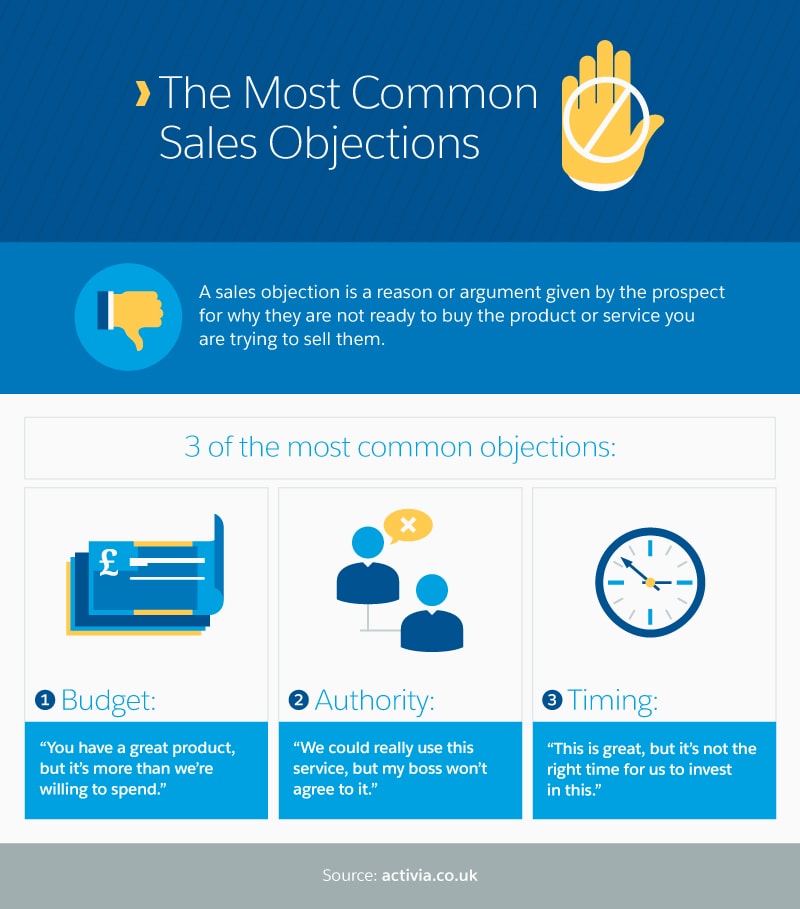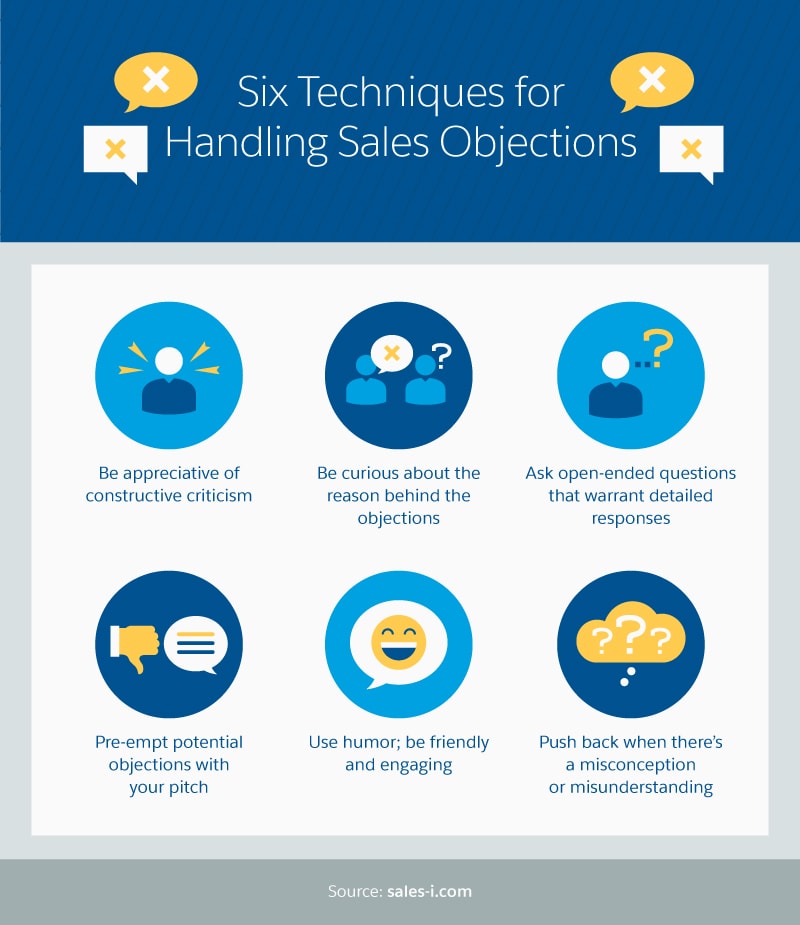Sales isn’t always smooth sailing. Clients and potential customers often have objections or concerns that salespeople must be able to respond to. Those objections can be related to the product, its price, your company, or any number of factors. And while you can’t always anticipate those objections, you need to be able to handle them to the best of your ability if you want to close sales.
A sales objection isn’t the same as “no,” but many new salespeople lose their momentum as soon as a potential customer voices concern. In this article, you’ll learn how to best handle those sales objections, from potential deal-breakers to smaller negotiations. With that knowledge, you’ll be better equipped to handle any rough waters that might come your way throughout the sales process.
Get fresh insights from 7,700 sales professionals.
Dig into our latest report to learn how sales professionals are driving productivity and efficiency.

Make Customers Feel They’re Heard
Often, when customers voice concerns, they just want to be heard. That doesn’t mean you can just nod your head as they speak and ignore the content of their objections. The first step in actually addressing any concerns or issues is simply to listen to the customer: Take in the information and demonstrate your understanding. In fact, The Institute of Customer Service’s UK Customer Satisfaction Index found that 60% of consumers won’t accept low service levels in exchange for lower prices, so the way you respond to concerns initially can make a big difference.
That means you need to let them voice their concern fully and without interrupting. Acknowledge the issue and let them know their concern is valid —don’t try to convince the customer the issue won’t affect them in order to move them forward in the buying process. If you don’t actually address the problem, however, the customer is more likely to let that concern become a real issue and potentially withdraw from the sale. Show genuine concern for their issue, and build legitimate trust, and you could be well on your way to solving it and making the sale.

Talk Through Concerns
After you’ve actively listened to a prospect’s concerns, it’s important to talk about those issues to discover what’s behind them. There may be more to the story than you or they realise. If you get through to the underlying issues, you can greatly improve your chances of successfully handling sales objections.
For example, if a customer says the price of your product or service is too high (which is one of the most common customer objections in the UK), ask them what price they would feel comfortable paying. During this discussion, you and the customer may realise that the issue is not really with the actual price, but more with the perceived value of the product. In that case, try offering a trial period, or share testimonials to show proof of the product or service’s value.
In addition, when customers fully voice their concerns, talking through those issues can help give you a better understanding of their needs so you can come up with solutions. For instance, if the customer’s issue really is budget, and therefore the product’s price, you could direct them to a budget-friendly version or potentially even adjust the price to complete the sale. Either way, you need to fully understand the customer’s objections before coming up with satisfactory solutions. It’s imperative that you ask questions and fully discuss any issues.
Carefully Consider the Objection
Once you’re sure about the reasons behind the objection, it’s time to formulate a solution. Each objection likely requires a different outcome, and you may need to work with the potential customer to find out exactly what they think would be an acceptable solution, then try to create that solution in your organisation.
If, for instance, a customer is worried that the product doesn’t have as many features as a competing product, show them how some of your existing customers find creative and different uses for your product in order to mimic those extra features. You could also point them in the direction of an add-on product that would resolve their concerns.
However, if a potential customer doesn’t know what outcome would be acceptable enough to make them buy, you have to get creative and come up with some suggestions. In some cases, customers may think they just don’t need the product or service right now, so they’re unlikely to come up with a solution that would get them to buy. In those instances, show them the tangible benefits that come from buying the product immediately, along with what they might miss out on if they wait. You could even offer them a guarantee of some kind that would give them a refund if they don’t achieve certain results within a defined time frame. This type of solution can ease concerns and make a product or service seem more appealing to customers who have more general concerns or objections.

Confirm the Solution
As much as you might want to, you can’t handle every sales objection on your own. Coming up with solutions requires feedback from customers. Ideally, you should ask them early in the process to get a good feel for which types of solutions may work, but you still need to confirm those solutions with the customers as well.
If your customer’s concern lies with the value of the product, a trial period could be a decent solution to show them what they will actually get out of it. However, what you think is not as important as what the customer thinks. Before you go through the process of setting up a trial, for example, ask the customer, “Would you feel more comfortable if you could try the product for yourself first?” This allows them to be part of the solution and makes them feel heard as well.
Additionally, if the solution you’ve come up with doesn’t resonate with them, then you can focus your efforts on coming up with something that does, rather than setting up a solution that isn’t going to help you make the sale in the first place.
Take the Concern to the Respective Departments
Sometimes sales objections are small and don’t impact multiple customers. Other times they come up repeatedly. As a salesperson, you likely only have direct control over your own sales. However, as a customer-facing team member, you can provide insights to other departments to make more customers satisfied and likely to buy. Take notes in your CRM, run reports to find the most common objections from leads, and act.
Take recurring objections to the affected departments within your company. For example, if customers who use a free trial of your product were generally happy but wouldn’t ultimately convert because of a programming glitch, speak with your developers to get it fixed.
When multiple leads are unconvinced due to price, then you might speak with your product development or management teams to see if adjustments are possible. If you solve these issues, you can effectively remove these objections and improve your ability to close more sales.

Proactively Address Concerns
You’ll also learn about your own sales process as you figure out how to handle sales objections. It’s likely that over the years you’ll deal with more than one customer who has concerns about pricing. As you deal with those customers, you’ll develop an idea about what avenues are likely to work best when addressing those concerns, and you can refine your pitch.
If, for example, you notice that a lot of customers who want to discuss price are actually more concerned about other issues, then you know to spend time asking them questions about their concerns, rather than immediately suggesting budget-minded solutions.
There are many techniques for handling sales objections that you can use to improve your chances of closing deals. And while there are some essential steps to the process, each customer — and each sale — is different. Only 2% of sales occur at the first meeting, according to Marketing Donut.
That means you have to listen and work with customers to come up with solutions. You’ll likely develop some processes that work better than others so you can proactively address customer concerns to eliminate as many sales objections as possible. Then you should be well on your way to improving overall sales and building a satisfied base of customers.
Share “How to Effectively Respond to Sales Objections” On Your Site

























